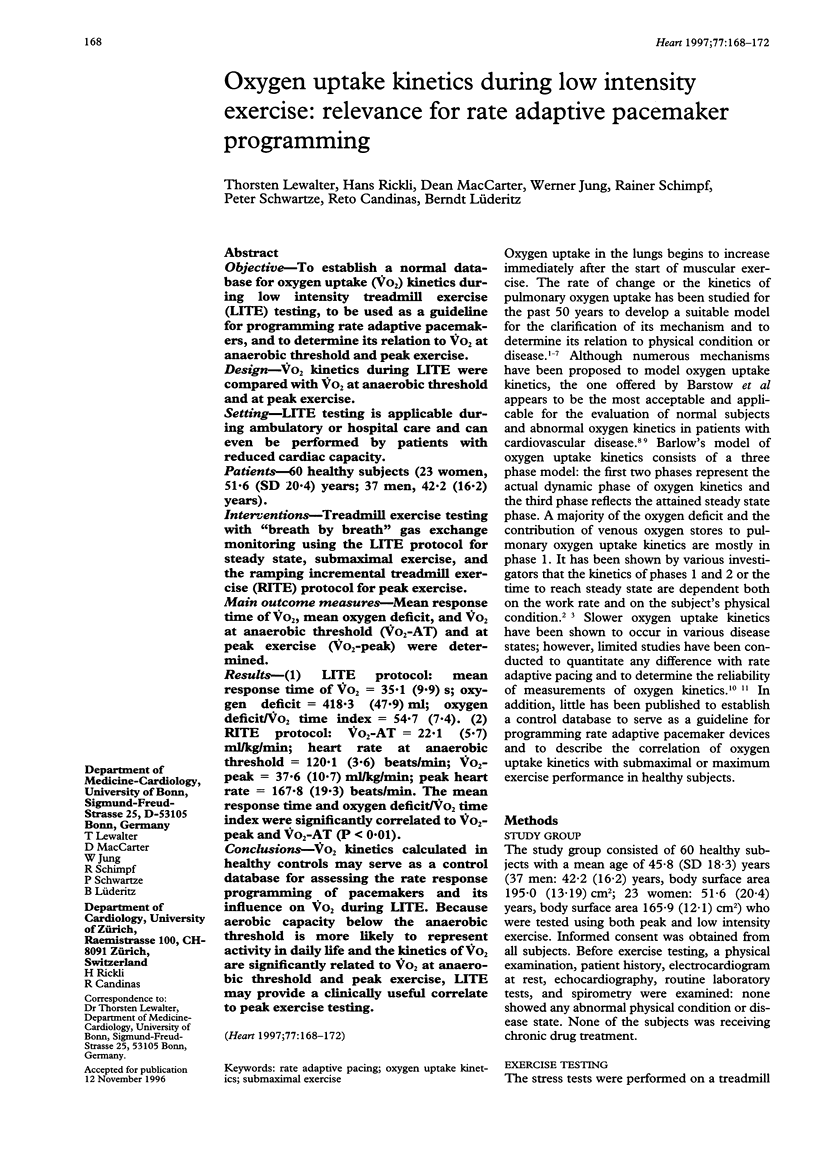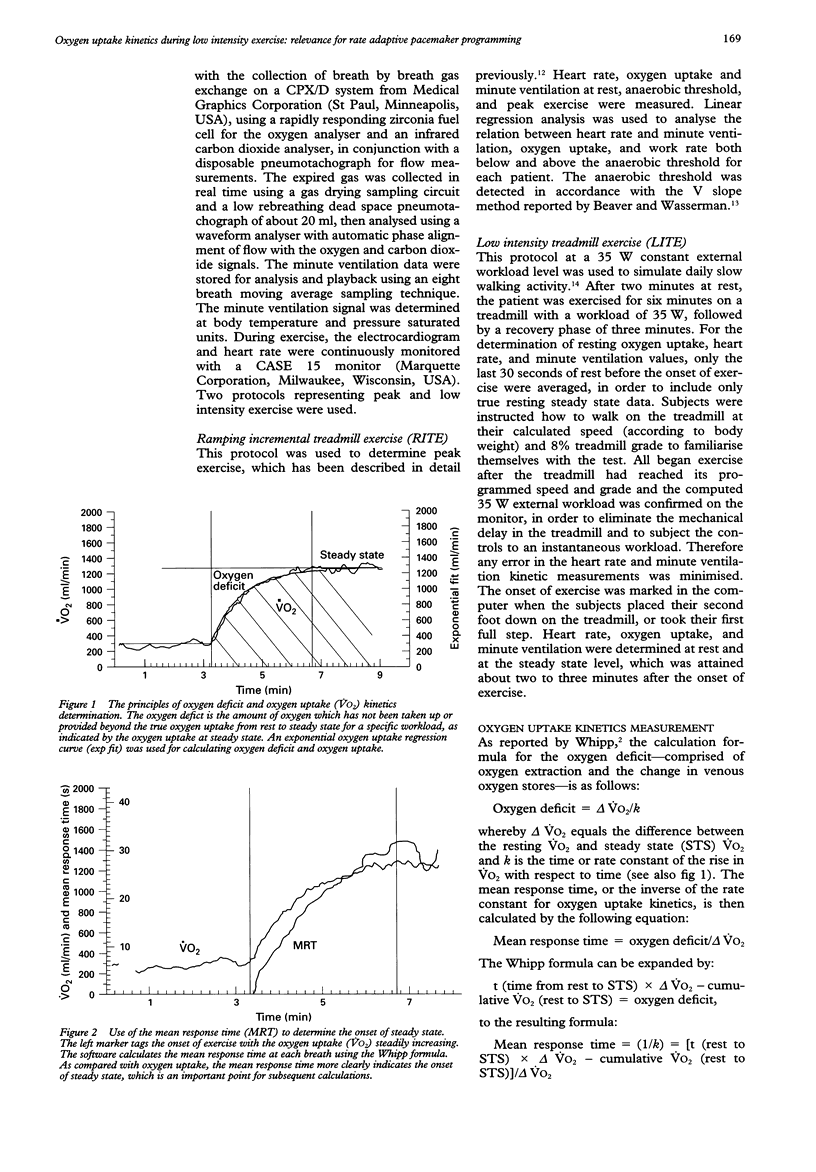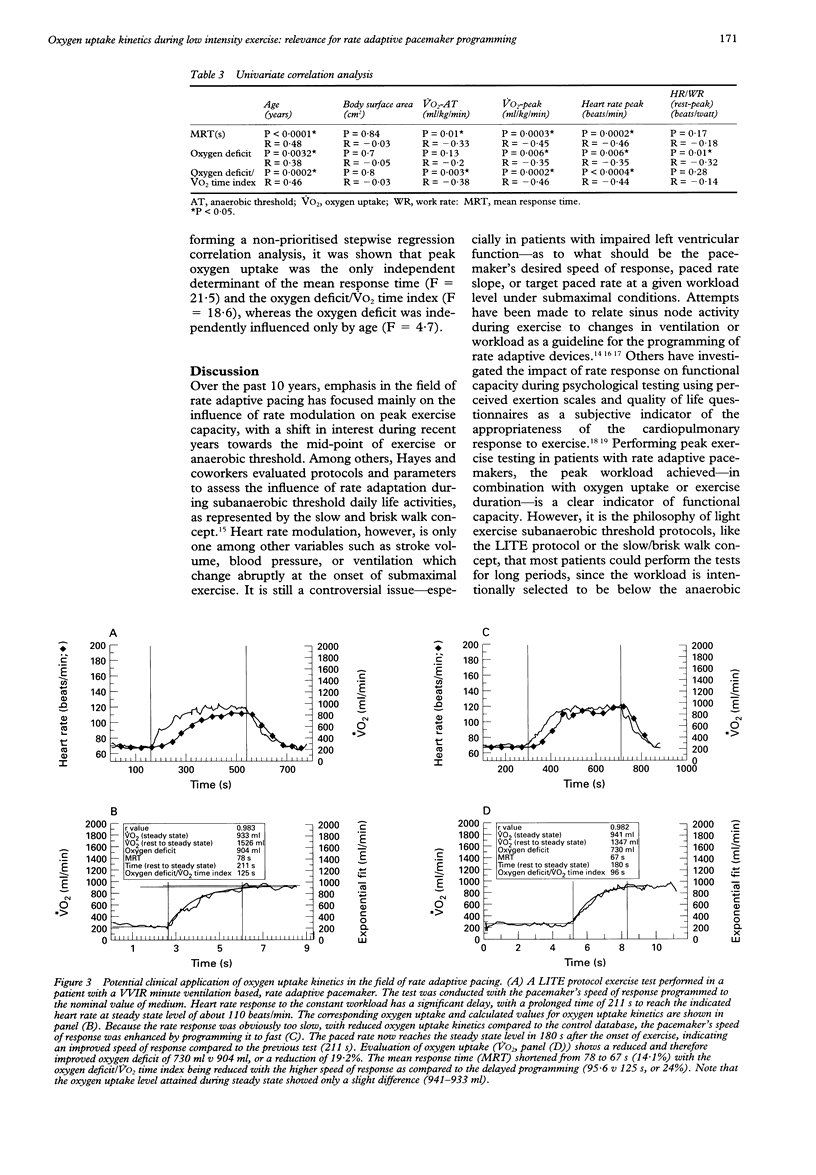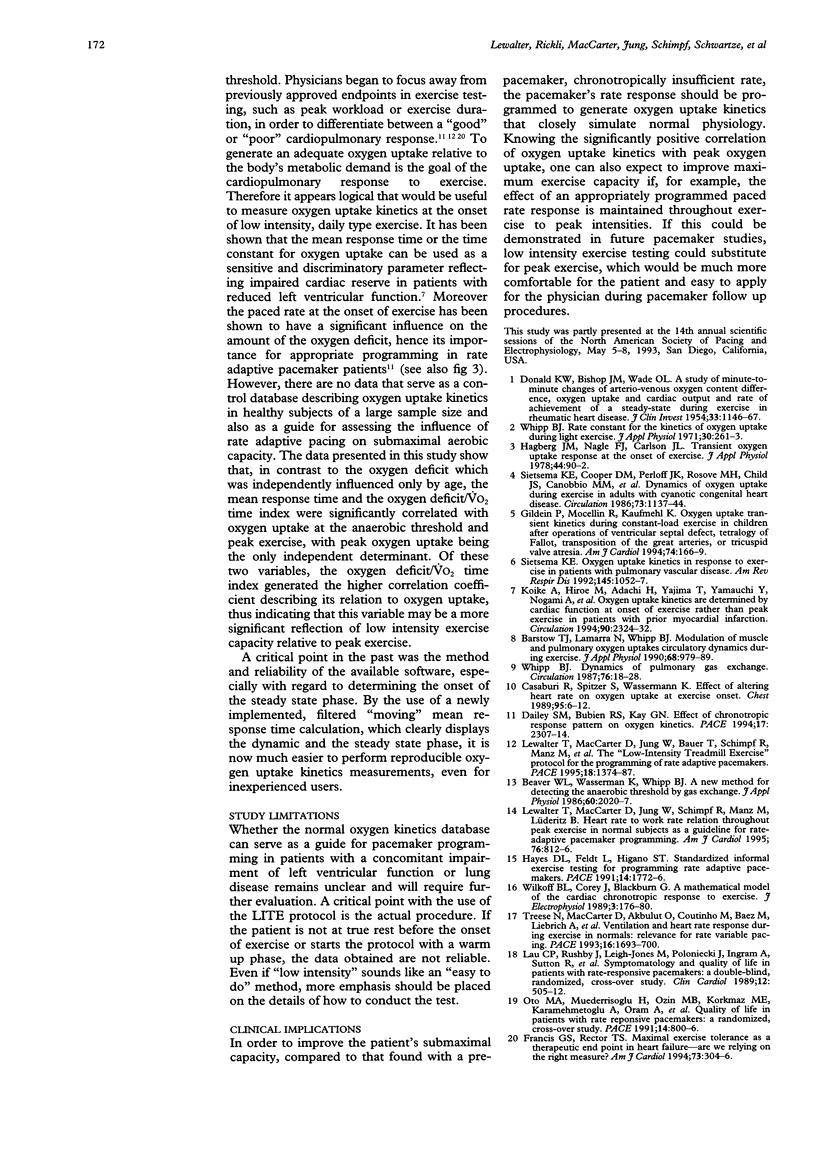Abstract
OBJECTIVE: To establish a normal database for oxygen uptake (VO2) kinetics during low intensity treadmill exercise (LITE) testing, to be used as a guideline for programming rate adaptive pacemakers, and to determine its relation to VO2 at anaerobic threshold and peak exercise. DESIGN: VO2 kinetics during LITE were compared with VO2 at anaerobic threshold and at peak exercise. SETTING: LITE testing is applicable during ambulatory or hospital care and can even be performed by patients with reduced cardiac capacity. PATIENTS: 60 healthy subjects (23 women, 51.6 (SD 20.4) years; 37 men, 42.2 (16.2) years). INTERVENTIONS: Treadmill exercise testing with "breath by breath" gas exchange monitoring using the LITE protocol for steady state, submaximal exercise, and the ramping incremental treadmill exercise (RITE) protocol for peak exercise. MAIN OUTCOME MEASURES: Mean response time of VO2, mean oxygen deficit, and VO2 at anaerobic threshold (VO2-AT) and at peak exercise (VO2-peak) were determined. RESULTS: (1) LITE protocol: mean response time of VO2 = 35.1 (9.9) s; oxygen deficit = 418.3 (47.9) ml; oxygen deficit/VO2 time index = 54.7 (7.4). (2) RITE protocol: VO2-AT = 22.1 (5.7) ml/kg/min; heart rate at anaerobic threshold = 120.1 (3.6) beats/min; VO2-peak = 37.6 (10.7) ml/kg/min; peak heart rate = 167.8 (19.3) beats/min. The mean response time and oxygen deficit/VO2 time index were significantly correlated to VO2-peak and VO2-AT (P < 0.01). CONCLUSIONS: VO2 kinetics calculated in healthy controls may serve as a control database for assessing the rate response programming of pacemakers and its influence on VO2 during LITE. Because aerobic capacity below the anaerobic threshold is more likely to represent activity in daily life and the kinetics of VO2 are significantly related to VO2 at anaerobic threshold and peak exercise, LITE may provide a clinically useful correlate to peak exercise testing.
Full text
PDF




Selected References
These references are in PubMed. This may not be the complete list of references from this article.
- Barstow T. J., Lamarra N., Whipp B. J. Modulation of muscle and pulmonary O2 uptakes by circulatory dynamics during exercise. J Appl Physiol (1985) 1990 Mar;68(3):979–989. doi: 10.1152/jappl.1990.68.3.979. [DOI] [PubMed] [Google Scholar]
- Beaver W. L., Wasserman K., Whipp B. J. A new method for detecting anaerobic threshold by gas exchange. J Appl Physiol (1985) 1986 Jun;60(6):2020–2027. doi: 10.1152/jappl.1986.60.6.2020. [DOI] [PubMed] [Google Scholar]
- Casaburi R., Spitzer S., Haskell R., Wasserman K. Effect of altering heart rate on oxygen uptake at exercise onset. Chest. 1989 Jan;95(1):6–12. doi: 10.1378/chest.95.1.6. [DOI] [PubMed] [Google Scholar]
- DONALD K. W., BISHOP J. M., WADE O. L. A study of minute to minute changes of arterio-venous oxygen content difference, oxygen uptake and cardiac output and rate of achievement of a steady state during exercise in rheumatic heart disease. J Clin Invest. 1954 Aug;33(8):1146–1167. doi: 10.1172/JCI102988. [DOI] [PMC free article] [PubMed] [Google Scholar]
- Dailey S. M., Bubien R. S., Kay G. N. Effect of chronotropic response pattern on oxygen kinetics. Pacing Clin Electrophysiol. 1994 Dec;17(12 Pt 1):2307–2314. doi: 10.1111/j.1540-8159.1994.tb02381.x. [DOI] [PubMed] [Google Scholar]
- Francis G. S., Rector T. S. Maximal exercise tolerance as a therapeutic end point in heart failure--are we relying on the right measure? Am J Cardiol. 1994 Feb 1;73(4):304–306. doi: 10.1016/0002-9149(94)90238-0. [DOI] [PubMed] [Google Scholar]
- Gildein P., Mocellin R., Kaufmehl K. Oxygen uptake transient kinetics during constant-load exercise in children after operations of ventricular septal defect, tetralogy of Fallot, transposition of the great arteries, or tricuspid valve atresia. Am J Cardiol. 1994 Jul 15;74(2):166–169. doi: 10.1016/0002-9149(94)90091-4. [DOI] [PubMed] [Google Scholar]
- Hagberg J. M., Nagle F. J., Carlson J. L. Transient O2 uptake response at the onset of exercise. J Appl Physiol Respir Environ Exerc Physiol. 1978 Jan;44(1):90–92. doi: 10.1152/jappl.1978.44.1.90. [DOI] [PubMed] [Google Scholar]
- Hayes D. L., Von Feldt L., Higano S. T. Standardized informal exercise testing for programming rate adaptive pacemakers. Pacing Clin Electrophysiol. 1991 Nov;14(11 Pt 2):1772–1776. doi: 10.1111/j.1540-8159.1991.tb02764.x. [DOI] [PubMed] [Google Scholar]
- Koike A., Hiroe M., Adachi H., Yajima T., Yamauchi Y., Nogami A., Ito H., Miyahara Y., Korenaga M., Marumo F. Oxygen uptake kinetics are determined by cardiac function at onset of exercise rather than peak exercise in patients with prior myocardial infarction. Circulation. 1994 Nov;90(5):2324–2332. doi: 10.1161/01.cir.90.5.2324. [DOI] [PubMed] [Google Scholar]
- Lau C. P., Rushby J., Leigh-Jones M., Tam C. Y., Poloniecki J., Ingram A., Sutton R., Camm A. J. Symptomatology and quality of life in patients with rate-responsive pacemakers: a double-blind, randomized, crossover study. Clin Cardiol. 1989 Sep;12(9):505–512. doi: 10.1002/clc.4960120907. [DOI] [PubMed] [Google Scholar]
- Lewalter T., MacCarter D., Jung W., Bauer T., Schimpf R., Manz M., Lüderitz B. The "low intensity treadmill exercise" protocol for appropriate rate adaptive programming of minute ventilation controlled pacemakers. Pacing Clin Electrophysiol. 1995 Jul;18(7):1374–1387. doi: 10.1111/j.1540-8159.1995.tb02599.x. [DOI] [PubMed] [Google Scholar]
- Lewalter T., MacCarter D., Jung W., Schimpf R., Manz M., Lüderitz B. Heart rate to work rate relation throughout peak exercise in normal subjects as a guideline for rate-adaptive pacemaker programming. Am J Cardiol. 1995 Oct 15;76(11):812–816. doi: 10.1016/s0002-9149(99)80233-1. [DOI] [PubMed] [Google Scholar]
- Oto M. A., Müderrisoglu H., Ozin M. B., Korkmaz M. E., Karamehmetoglu A., Oram A., Oram E., Ugurlu S. Quality of life in patients with rate responsive pacemakers: a randomized, cross-over study. Pacing Clin Electrophysiol. 1991 May;14(5 Pt 1):800–806. doi: 10.1111/j.1540-8159.1991.tb04110.x. [DOI] [PubMed] [Google Scholar]
- Sietsema K. E., Cooper D. M., Perloff J. K., Rosove M. H., Child J. S., Canobbio M. M., Whipp B. J., Wasserman K. Dynamics of oxygen uptake during exercise in adults with cyanotic congenital heart disease. Circulation. 1986 Jun;73(6):1137–1144. doi: 10.1161/01.cir.73.6.1137. [DOI] [PubMed] [Google Scholar]
- Sietsema K. E. Oxygen uptake kinetics in response to exercise in patients with pulmonary vascular disease. Am Rev Respir Dis. 1992 May;145(5):1052–1057. doi: 10.1164/ajrccm/145.5.1052. [DOI] [PubMed] [Google Scholar]
- Treese N., MacCarter D., Akbulut O., Coutinho M., Baez M., Liebrich A., Meyer J. Ventilation and heart rate response during exercise in normals: relevance for rate variable pacing. Pacing Clin Electrophysiol. 1993 Aug;16(8):1693–1700. doi: 10.1111/j.1540-8159.1993.tb01040.x. [DOI] [PubMed] [Google Scholar]
- Whipp B. J. Rate constant for the kinetics of oxygen uptake during light exercise. J Appl Physiol. 1971 Feb;30(2):261–263. doi: 10.1152/jappl.1971.30.2.261. [DOI] [PubMed] [Google Scholar]


